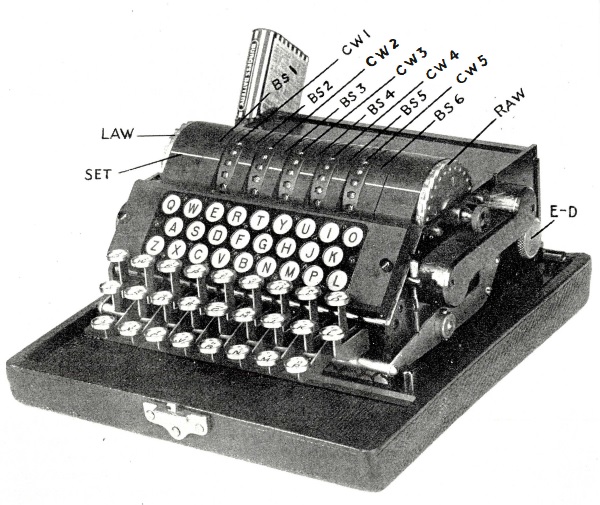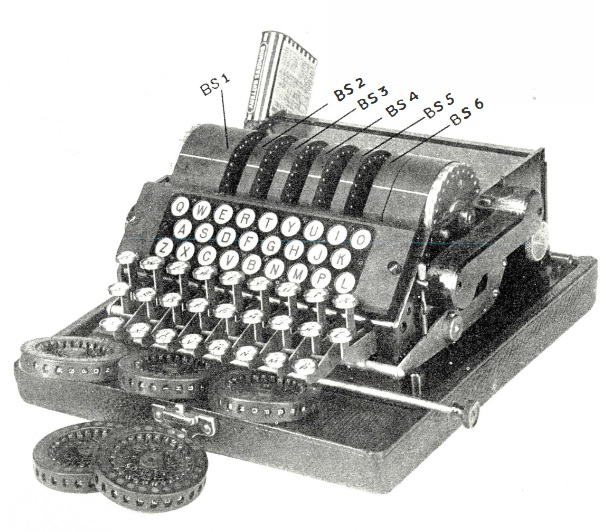Hebern 5 rotors cipher machine
Hebern's machines
- HCM 5 rotors home page
(this page) - HCM description
- Genuine messages
- Navy 1924 Challenge
- Poem
- Cryptanalyse
- Friedman's report
- Simulator
- Emulator in paper
- Challenges
Introduction
In 1917, the American Hebern invented a cipher machine. The ciphering element is a single rotor. Then he creates a machine with 3 rotors and ultimately a 5-rotors machine.
In 1923, he presented this five-rotors version to the American Navy.
 |
 |
History of the machine
Note: The history of Hebern machines and cipher machines and overall American is not easy to reconstruct. In fact the different sources often provide contradictory and often undated information or dated but each time different.
In 1917, Hebern invented an encryption machine whose encryption element was a rotor.
At the beginning of 1921, he presented his machine in a Navy magazine and presents his machine as “unbreakable”. Miss Agnes Meyer (Agnes Driscol after she gets married) cryptanalyst in the Navy's Code and Signal Section, solved the sample message. Hebern goes to Washington, files a patent for his machine and present it at the Navy. Although his message has been deciphered, the Navy is very interested because it wishes (like most navies in the world), to equip itself with cipher machines. Also in 1921, he created the company "Hebern Electric Code" with capital of one million of dollars.
In 1923, he hired Agnes Driscoll as an advisor and liaison with the Navy. Agnes Driscoll advises him to transform his 3-rotors machine into a five-rotors machine. He considers his machine, again, “unbreakable”.
Hebern presents his machine to the American Navy. The Navy is enthusiastic. On July 30, the Navy purchased 2 machines for $600 each [1] and promised Hebern to buy others later after having studied them.
At the end of 1923, the "Chief Signal Officer" of the American army ordered the company to Hebern, two machines to find out if this type of machine is suitable for the needs of the army, at a price of $500 each. If the army is interested in these machines, it is without doubt linked to the enthusiasm shown by the navy towards them. These machines are studied by Friedman. As soon as he understood how they worked, Friedman presented his Navy counterpart (Lieutenant Struble), a message he encrypted with one of its machines, which the Navy cannot decipher. Friedman concluded that Navy and Army machines use differently wired rotors.
In 1924, the American Navy was ready to adopt this machine as top level encryption means. The Navy releases a budget of $75,000 to negotiate with Hebern.
However, the Navy asks William Friedman, the cryptanalyst chief of the Army, to test the security of the machine by trying to decipher a set of ten messages. Friedman achieved the feat of deciphering all of the messages.
Note: W. Friedman was already known for having succeeded in several challenges by breaking several systems in 1918: The Pletts system (similar to Wheatstone's device) and an encrypting ATT teletype.
Following Friedman's exploit, the US Navy abandoned the idea of order this version of Hebern's cipher machine. The Navy remains in contact with Hebern. He would develop a improved version of its machine few years later ... (cf. Hebern 5 rotors cipher machine v2, link).
Note [1]: $500 in 1924 represents approximately $9,000 in 2023. The annual salary of a librarian in 1924 is about $1,700.
References
- The Codebreakers, The Story of Secret Writing, by David Kahn, Scribner Editor, 1967, 1996.
- Machine Cryptography and Modern Cryptanalysis, by Cipher A. Deavours & Louis Kruh, Artech House Editor, 1985.
Web Links
- Pattent of HCP 5 rotors, First version (1923) (link)
- NSA - Sources in Cryptologie History Number 3 - The Friedman Legacy - (link)
-
Smithsonian - Hebern Electric Super Code Cipher Machine
(link).
Note: On this site you can see several photos of a Hebern 5-rotor machine, in particular of the case which allows its transport. - TWO HEBERN CRYPTOGRAPHIC MACHINES Peter Zilahy Ingerman, Cryptologia, Volume 29, 2005 - Issue 2 (link). Note: This paper describes the author's attempt to bring two Hebern cryptographic machines back into operating condition. While the attempt failed (because of the conflicting constraints of maintaining the historical integrity of the machines versus getting the machines to work), a great deal was learned about the internal construction of the machines, and is documented here with.
- U.S. Naval Cryptologic Veterans Association - Madame X — Agnes Meyer Driscoll (link).
-
Espacenet - Pattent - CA290279A MACHINE ELECTRIQUE A CODE - 1929
(
link).
A priori this patent is for the Hebern 5 rotor v1 machine.